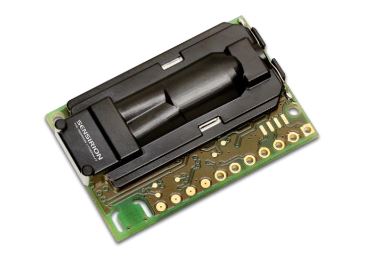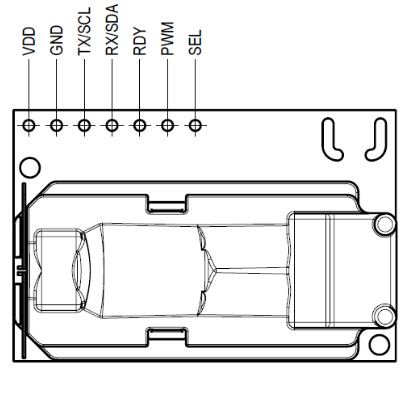This document explains how to set up a SCD30 sensor to run on a embedded device using the provided code.
Click here to learn more about the Sensirion SCD30 sensor.
The default I²C address of SCD30 is 0x61.
Your sensor has 5 different signals that need to be connected to your board: VDD, GND, SCL, SDA, SEL. Use the following pins to connect your SCD30:
| Pin | Cable Color | Name | Description | Comments |
|---|---|---|---|---|
| 1 | red | VDD | Supply Voltage | 3.3 to 5.5V |
| 2 | black | GND | Ground | |
| 3 | yellow | SCL | I2C: Serial clock input | |
| 4 | green | SDA | I2C: Serial data input / output | |
| 5 | RDY | High when data is available | do not connect | |
| 6 | PWM | do not connect | ||
| 7 | blue | SEL | Interface select | Pull to ground or floating for I2C |
The recommended voltage is 3.3V.
In order to use the provided code we need to adjust two files according to your platform.
This file contains the implementation of the sensor communication, which
depends on your hardware platform. We provide function stubs for your
hardware's own implementation.
Sample implementations are available for some platforms:
sample-implementations. For Linux based platforms
like Raspberry Pi you can just replace the unimplemented HAL template with the
implementation in sample-implementations/linux_user_space/:
cp sample-implementations/linux_user_space/sensirion_i2c_hal.c ./
Skip this part for Linux based platforms since everything is already setup for this case.
Otherwise you need to check if the libraries <stdint.h> and <stdlib.h> are
provided by your toolchain, compiler or system. If you have no idea on how to
do that you can skip this step for now and come back when you get errors
related to these names when compiling the driver.
The features we use from those libraries are type definitions for integer sizes
from <stdint.h> and NULL from <stdlib.h>. If they are not available you
need to specify the following integer types yourself:
int64_t= signed 64bit integeruint64_t= unsigned 64bit integerint32_t= signed 32bit integeruint32_t= unsigned 32bit integerint16_t= signed 16bit integeruint16_t= unsigned 16bit integerint8_t= signed 8bit integeruint8_t= unsigned 8bit integer
In addition to that you will need to specify NULL. For both we have a
detailed template where you just need to fill in your system specific values.
Now we are ready to compile and run the example usage for your sensor.
Pass the source .c and header .h files in this folder into your C compiler
and run the resulting binary. This step may vary, depending on your platform.
Here we demonstrate the procedure for Linux based platforms:
- Open up a terminal.
- Navigate to the directory where this README is located.
- Run
make(this compiles the example code into one executable binary). - Run the compiled executable with
./scd30_i2c_example_usage - Now you should see the first measurement values appear in your terminal. As a next step you can adjust the example usage file or write your own main function to use the sensor.
In these files you can find the implementation of the I2C protocol used by Sensirion sensors. The functions in these files are used by the embedded driver to build the correct frame out of data to be sent to the sensor or receive a frame of data from the sensor and convert it back to data readable by your machine. The functions in here calculate and check CRCs, reorder bytes for different byte orders and build the correct formatted frame for your sensor.
These files contain the implementation of the hardware abstraction layer used
by Sensirion's I2C embedded drivers. This part of the code is specific to the
underlying hardware platform. This is an unimplemented template for the user to
implement. In the sample-implementations/ folder we provide implementations
for the most common platforms.
In this file we keep all the included libraries for our drivers and global
defines. Next to sensirion_i2c_hal.c it's the only file you should need to
edit to get your driver working.
In these files you can find some helper functions used by Sensirion's embedded drivers. It mostly contains byte order conversions for different variable types. These functions are also used by the UART embedded drivers therefore they are kept in their own file.
Contributions are welcome!
We develop and test this driver using our company internal tools (version control, continuous integration, code review etc.) and automatically synchronize the master branch with GitHub. But this doesn't mean that we don't respond to issues or don't accept pull requests on GitHub. In fact, you're very welcome to open issues or create pull requests :)
This Sensirion library uses
clang-format to standardize the
formatting of all our .c and .h files. Make sure your contributions are
formatted accordingly:
The -i flag will apply the format changes to the files listed.
clang-format -i *.c *.hNote that differences from this formatting will result in a failed build until they are fixed.
See LICENSE.

